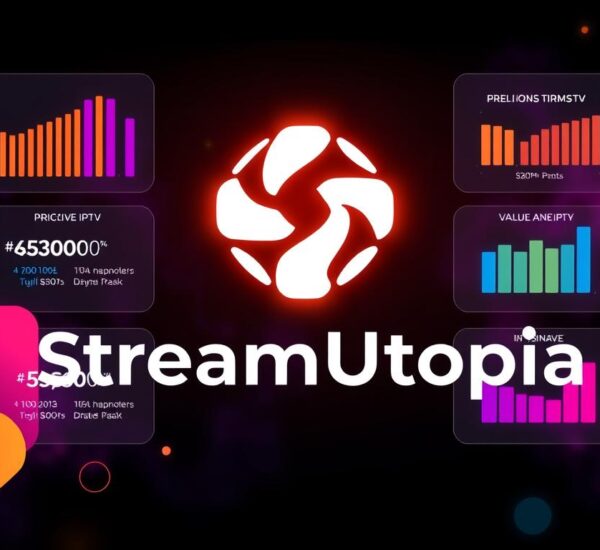Did you know that the global video streaming industry is projected to consume as much as 250 terawatt-hours of electricity by 2030? That’s equivalent to the energy consumption of the entire United Kingdom for a year!
In today’s digital age, where video content has become an integral part of our lives, it’s crucial to consider the environmental impact of streaming services. As more and more people embrace the convenience and entertainment of video streaming, the energy consumption and carbon footprint of the industry continue to grow exponentially.
However, there is hope. With a focus on environmental education and sustainable practices, the IPTV (Internet Protocol Television) industry can play a significant role in promoting sustainability and mitigating its environmental impact.
Key Takeaways:
- The global video streaming industry is projected to consume 250 terawatt-hours of electricity by 2030.
- IPTV can contribute to promoting sustainability and reducing the carbon footprint of the streaming industry.
- Environmental education and sustainable practices are crucial for minimizing the environmental impact of video content consumption.
- Transitioning to renewable energy sources and optimizing data center efficiency are key steps towards sustainability in video streaming.
- Collaborations and advancements in CDN technology can further enhance sustainability efforts in the industry.
The Role of CDNs in Reducing the Environmental Impact of Video Streaming
CDNs, or Content Delivery Networks, play a critical role in efficiently delivering video streaming content to users worldwide. However, the operation of CDNs can result in a significant environmental impact due to their high energy consumption. To address this issue and promote sustainability, several measures can be taken in CDN operations.
One key step is transitioning to renewable energy sources to power CDN data centers. By harnessing energy from renewable sources such as solar, wind, or hydroelectric power, CDNs can significantly reduce their carbon footprint and minimize the environmental impact of their operations.
Data center efficiency also plays a vital role in reducing energy consumption in CDNs. Implementing advanced cooling technologies and optimizing server management practices can help minimize power usage and increase overall energy efficiency. These improvements not only reduce the environmental impact but also contribute to cost savings.
In addition, adopting green coding practices and utilizing energy-efficient streaming protocols can further mitigate the environmental impact of CDNs. By reducing server load and optimizing data transmission processes, CDNs can minimize energy consumption and maximize the efficiency of video streaming services.
Benefits of CDN Environmental Initiatives
The environmental initiatives undertaken by CDNs not only contribute to sustainability but also offer additional benefits. Some of these include:
- Reduced greenhouse gas emissions
- Enhanced brand reputation through promoting sustainability
- Cost savings through decreased energy consumption
- A positive environmental impact
By implementing these sustainable practices, CDNs can play a crucial role in reducing the environmental impact of video streaming and contribute to a greener future.
| Environmental Impact | Key Strategies |
|---|---|
| Energy Consumption | Transition to renewable energy sources |
| Data Center Efficiency | Implement advanced cooling technologies and optimize server management |
| Green Coding Practices | Adopt energy-efficient coding practices and protocols |
Sustainable Practices in CDN Operations for Video Streaming
Implementing sustainable practices in CDN operations is crucial for reducing the environmental impact of video streaming. By optimizing various aspects of CDN operations and leveraging industry-wide collaborations, the streaming industry can contribute to a greener future.
CDN Caching Strategies
Effective caching strategies play a pivotal role in minimizing data center resource utilization and reducing energy consumption. By strategically caching popular and frequently accessed content closer to end users, CDNs can minimize the need for frequent content retrieval from the origin server. As a result, the overall energy consumption and network congestion can be significantly reduced.
Optimizing Streaming Settings
Another essential sustainable practice is optimizing streaming settings for energy efficiency. By implementing adaptive streaming techniques, CDNs can dynamically adjust the quality and bitrates of the video stream based on the viewer’s network conditions. This helps to reduce bandwidth requirements and minimize energy consumption, especially in situations where high-quality video is not necessary.
Green Hosting and Cloud Services
Utilizing green hosting and cloud services is another way to support sustainability in CDN operations. Green hosting providers prioritize renewable energy sources and energy-efficient infrastructure in their data centers. CDNs can partner with such providers to ensure that their operations are powered by clean energy, further reducing their carbon footprint.
Encouraging Low-Impact Video Formats
Encouraging the use of low-impact video formats is vital for reducing energy consumption in video streaming. Codecs like AV1 and VP9 offer superior compression efficiency, allowing for high-quality video with reduced file sizes. By promoting the adoption of these formats, CDNs can minimize bandwidth requirements and energy consumption during content delivery.
Industry-Wide Collaborations
Establishing industry-wide collaborations is critical for setting standards and best practices for sustainable video streaming. Collaborative efforts can focus on sharing knowledge, conducting research, and developing guidelines that promote energy-efficient CDN operations. By working together, CDNs can collectively contribute to minimizing the environmental impact of video streaming.
| Benefit | Description |
|---|---|
| Reduced Energy Consumption | Efficient caching strategies, optimized streaming settings, and low-impact video formats help reduce the overall energy consumption of CDN operations. |
| Lower Carbon Footprint | Utilizing green hosting and cloud services, along with industry-wide collaborations, enables CDNs to minimize their carbon footprint and contribute to sustainability. |
| Improved Efficiency | By adopting sustainable practices, CDNs can enhance the efficiency of their operations, leading to cost savings and optimized resource utilization. |
| Environmental Stewardship | Embracing sustainable practices demonstrates a commitment to environmental stewardship, enhancing brand reputation and customer loyalty. |
By implementing sustainable practices in CDN operations, the streaming industry can pave the way for a more eco-friendly and energy-efficient future.
Advancements in CDN Technology for Enhanced Sustainability
Advancements in CDN (Content Delivery Network) technology have played a significant role in enhancing sustainability in the streaming industry. By incorporating innovative solutions and leveraging cutting-edge algorithms, CDNs can effectively reduce energy consumption and minimize their environmental impact.
Integration of Machine Learning Algorithms
One of the key advancements in CDN technology is the integration of machine learning algorithms. These algorithms analyze and optimize the delivery of content, resulting in reduced energy consumption. By intelligently directing traffic and dynamically adjusting caching strategies, CDNs can minimize server load and optimize resource utilization.
Edge Computing for Energy Efficiency
Another important technological advancement is the implementation of edge computing in CDN operations. Edge computing involves processing and storing data closer to the end-user, minimizing the need for long-haul data transfers. This approach reduces the energy required for data delivery and enables more efficient routing, resulting in lower latency and improved sustainability.
IPv6: Efficient Routing for Sustainability
CDNs have also embraced the use of IPv6, the latest version of the Internet Protocol. IPv6 enables efficient routing capabilities and reduces energy usage. With its larger address space, IPv6 allows for more direct and efficient communication between devices, minimizing the number of network hops and thereby reducing energy consumption.
Low-Energy Hardware for CDN Nodes
Advancements in hardware design have led to the development of low-energy hardware specifically tailored for CDN nodes. These energy-efficient hardware solutions consume less power while maintaining optimal performance. By deploying such hardware, CDNs can significantly reduce their carbon footprint and contribute to a greener ecosystem.
Optimization with Content Popularity Algorithms
Content popularity algorithms are another innovation that enhances the sustainability of CDNs. By analyzing user behavior and content consumption patterns, these algorithms optimize caching strategies to ensure that frequently accessed content is readily available at edge locations. This reduces the need for server-to-client data transfers, conserving energy and improving overall efficiency.

Sustainability in the streaming industry goes beyond environmental impact; it also involves providing an efficient and reliable streaming experience for users. By embracing advancements in CDN technology, such as machine learning algorithms, edge computing, IPv6, low-energy hardware, and content popularity algorithms, CDNs can achieve the dual objectives of enhanced sustainability and improved user experience.
The Economic and Environmental Benefits of Sustainable CDN Practices
Adopting sustainable CDN practices not only contributes to a greener future but also brings a range of economic and environmental benefits. By implementing these practices, companies can make significant strides in reducing their carbon footprint and positively impacting the environment.
Economic Benefits
One of the key advantages of sustainable CDN practices is cost savings. By reducing energy consumption and optimizing data center efficiency, companies can lower their operational expenses. This is achieved through various initiatives such as transitioning to renewable energy sources, implementing advanced cooling technologies, and optimizing server management.
| Economic Benefits | Description |
|---|---|
| Cost Savings | Reduced energy consumption leads to lower operational expenses. |
| Positive Environmental Impact | Lower greenhouse gas emissions contribute to a healthier planet. |
| Marketing Benefits | Enhanced brand reputation and increased customer loyalty. |
| Regulatory Incentives | Tax breaks and other incentives promote sustainability. |
Environmental Benefits
Aside from the economic advantages, sustainable CDN practices have a positive environmental impact. By reducing energy consumption, companies can significantly decrease greenhouse gas emissions. This contributes to mitigating climate change and creating a healthier planet for future generations.
Marketing Benefits
Sustainable CDN practices also bring marketing benefits. Companies that prioritize sustainability demonstrate their commitment to environmental stewardship, enhancing their brand reputation. This resonates with environmentally conscious consumers who are more likely to choose eco-friendly products and services. By implementing sustainable CDN practices, companies can build stronger customer loyalty and attract new customers who align with their values.
Regulatory Incentives
The shift towards sustainability is further supported by regulatory incentives. Governments and regulatory bodies offer tax breaks, subsidies, and other incentives to encourage companies to adopt sustainable practices. Taking advantage of these incentives not only promotes sustainability but also helps businesses save costs and invest in further environmental initiatives.
Overall, the economic and environmental benefits of sustainable CDN practices are substantial. By reducing costs, minimizing environmental impact, enhancing brand reputation, and taking advantage of regulatory incentives, companies can transition towards a more sustainable future while reaping multiple rewards.
Sustainability in Gaming: Role-playing to Raise Awareness
Video games present a unique platform to educate players on climate change and sustainable development. The immersive nature of gaming allows for widespread awareness and engagement, making it an effective tool for promoting sustainability. Through creative storytelling, captivating visuals, and interactive gameplay, video games have the potential to spark meaningful conversations and educate players on important global issues.
One way video games contribute to sustainability is by incorporating gaming themes that align with the Sustainable Development Goals (SDGs). The SDGs are a set of global objectives established by the United Nations to address poverty, inequality, and environmental challenges. By integrating these goals into game narratives, developers can raise awareness and encourage players to think critically about real-world sustainability issues.
Several prominent game franchises have successfully integrated environmental issues into their gameplay. For example, the critically acclaimed game “Journey” takes players on a visually stunning adventure through a vast desert landscape, highlighting the importance of preserving natural environments. The popular game series “Animal Crossing” emphasizes sustainable living through activities such as fishing, farming, and recycling, promoting eco-friendly behaviors among players.
Moreover, video games can serve as a powerful educational tool, providing players with valuable knowledge and insights on climate change and sustainable development. Many games incorporate educational elements and resources within their gameplay, allowing players to learn about different ecosystems, renewable energy sources, and the impact of human activities on the environment. By gamifying these concepts, players can gain a deeper understanding of sustainability while enjoying the immersive gaming experience.
In addition to the educational aspect, the gaming industry itself has taken steps towards sustainability. Many game developers and publishers are implementing eco-friendly practices in their operations, such as reducing carbon emissions, optimizing energy consumption, and adopting green production models. These initiatives contribute to a more sustainable gaming ecosystem and align with the broader global efforts to combat climate change.
In summary, sustainability in gaming is not only about entertainment but also about raising awareness and educating players on climate change and sustainable development. Video games provide a powerful medium for engaging individuals in meaningful conversations about global issues. Through incorporating Sustainable Development Goals (SDGs) and promoting eco-friendly behaviors, the gaming industry can inspire players to become advocates for a greener future.
Building a Green Alliance: Video Gaming for Climate Action
The gaming industry has emerged as a powerful medium for promoting climate action and sustainability. The Playing for the Earth Alliance, a collective effort by game companies, has taken the lead in this movement. By formulating comprehensive strategies and adhering to ambitious sustainability targets, the alliance aims to harness the influence of video gaming to drive positive change.
As part of the Playing for the Earth Alliance, game companies commit to reducing their carbon footprints and adopting circular economy practices. This involves taking proactive measures to optimize energy consumption, minimize waste generation, and promote eco-friendly practices throughout the gaming value chain. By implementing sustainable initiatives, these companies set an example for the industry and inspire others to follow suit.
Video games have started to make a significant impact on climate and environmental action. They serve as a platform to educate and raise awareness about pressing issues such as climate change, deforestation, and pollution. Through engaging gameplay and immersive storytelling, video games inspire players to take action and contribute to real-world sustainability efforts.
To illustrate the potential of video gaming in driving climate action, let’s take a look at a few prominent examples:
Game-1:
In this game, players embark on a thrilling eco-adventure, taking on challenges that mirror real-world sustainability issues. By completing missions and making sustainable choices within the game, players learn about the importance of resource conservation, renewable energy, and biodiversity preservation.
Game-2:
This game places players in a post-apocalyptic world devastated by climate change. As they navigate through the virtual landscape, players witness the consequences of unsustainable practices and are prompted to make conscious decisions to mitigate the impact. Through these experiences, players gain a deeper understanding of the urgent need for climate action.
By leveraging the immersive nature of video games, developers have the ability to immerse players in scenarios that foster empathy and understanding of sustainability challenges. This, in turn, encourages players to make more informed choices in their daily lives and become active advocates for change.
Overall, the gaming industry has the potential to become a key player in global sustainability efforts. Through the combined efforts of game companies, industry-wide collaborations, and passionate gamers, video gaming can contribute to a greener and more sustainable future.
To further demonstrate the impact of video gaming on climate action, below is an example of the Playing for the Earth Alliance’s sustainability targets:
| Company | Carbon Footprint Reduction Target | Circular Economy Practices |
|---|---|---|
| Company A | 50% reduction by 2030 | Implementing recycled packaging materials |
| Company B | 100% renewable energy by 2025 | Integrating sustainable sourcing for in-game assets |
| Company C | Net-zero emissions by 2040 | End-of-life product recycling program |
The Playing for the Earth Alliance’s sustainability targets demonstrate the commitment of game companies towards building a green alliance. By making concrete commitments and driving sustainable practices within the gaming industry, these companies are setting a positive example for others to follow.
Through collaboration, innovation, and continued efforts, video gaming can contribute to climate action and help shape a sustainable future.
Reimagining Video Delivery in the Cloud for Sustainability
Traditional distribution methods for video content have inherent limitations when it comes to scalability, sustainability, and budget considerations. However, there is an alternative that offers a cost-effective and sustainable approach – IPTV in the cloud. By taking advantage of cloud-based content distribution, the industry can achieve global reach and nearly limitless capacity for innovation while embracing a greener production model.
IPTV in the cloud provides numerous benefits for video delivery. It eliminates the need for physical infrastructure, reducing the carbon footprint associated with traditional distribution methods. With cloud-based solutions, video content is stored and delivered through remote data centers, minimizing energy consumption and maximizing efficiency.
Furthermore, cloud-based content distribution enables seamless scalability. As demand for video content continues to rise, cloud platforms can effortlessly accommodate increasing viewership without experiencing significant performance hurdles. This scalability ensures a smooth viewing experience for audiences worldwide while reducing the strain on resources.
By embracing cloud-based solutions, the streaming industry can reimagine video delivery and strengthen its commitment to sustainability. The combination of IPTV and cloud technology offers a powerful toolset for content distributors to navigate the evolving landscape of digital media while minimizing environmental impact.
Benefits of Reimagining Video Delivery in the Cloud:
- Cost-effective and sustainable alternative to traditional distribution methods
- Global reach and nearly limitless capacity for innovation
- Reduced carbon footprint through the elimination of physical infrastructure
- Efficient utilization of resources with cloud-based solutions
- Seamless scalability to accommodate increasing viewership
To illustrate the potential impact of cloud-based video delivery, consider the following table:
| Traditional Distribution Methods | Cloud-based Video Delivery |
|---|---|
| Limited scalability | Seamless scalability |
| High energy consumption | Efficient resource utilization |
| Budget constraints | Cost-effective solution |
| Localized reach | Global accessibility |
As evident from the table, cloud-based video delivery offers a more sustainable and efficient approach compared to traditional distribution methods. By leveraging IPTV in the cloud, content distributors can unlock new possibilities for growth while minimizing their environmental impact.
With the rapid growth of digital media consumption, the need to embrace sustainable practices has become imperative. Reimagining video delivery in the cloud not only addresses the limitations of traditional methods but also paves the way for a more eco-friendly future in the streaming industry.
Modernizing Video Workflows at Scale with M2A Media
To meet the demands of a rapidly evolving media landscape, content distributors need efficient and scalable solutions. M2A Media, a leading provider of cloud-based video solutions, offers modernized video workflows that enable businesses to stay competitive and sustainable.
Built on AWS Media Services, M2A Media’s automated IPTV solutions provide a range of benefits, including scalability, cost efficiency, and sustainability. These solutions empower content distributors to optimize their operations and drive new revenue streams.
With M2A’s tools, content distributors can effectively manage costs by automating scheduling and operations. By streamlining workflows, manual processes are reduced, saving valuable time and resources. Additionally, M2A’s solutions offer the flexibility to scale video workflows in line with demand, ensuring efficient delivery and meeting customer expectations.
Besides scalability, M2A Media is committed to cost efficiency. By leveraging cloud-based infrastructure, businesses can avoid hefty upfront investments in hardware and infrastructure maintenance costs. This allows for more cost-effective video workflows and enables content distributors to allocate resources strategically.
Sustainability is also at the core of M2A Media’s offerings. By embracing cloud technology, businesses can reduce their environmental impact. Cloud-based solutions reduce the need for physical infrastructure, saving energy and minimizing carbon footprints. M2A’s commitment to sustainability aligns with the growing need for responsible business practices.
Key Advantages of M2A Media’s Modernized Video Workflows:
- Scalability: Accommodate fluctuating demand and ensure seamless video delivery.
- Cost Efficiency: Optimize costs through automation and cloud-based infrastructure.
- Sustainability: Minimize environmental impact by leveraging cloud technology.
M2A Media enables scalability, cost efficiency, and sustainability in video workflows.
Automating and Simplifying Content Distribution with M2A
M2A revolutionizes content distribution by automating the management of configurations and ensuring proper routing. Their cloud-based solutions simplify the process and enhance efficiency, making content delivery seamless for businesses of all sizes.
With M2A’s advanced tools, businesses can cater to live streams and orchestrate events with ease. These solutions enable flexible, scalable, and cost-effective video transport, ensuring a smooth streaming experience for viewers.
M2A’s cloud-based approach to content distribution offers numerous benefits, particularly for business-to-business distribution. By leveraging the power of the cloud, M2A facilitates secure and efficient delivery of video content to partners and clients around the world.
Table: Benefits of Automating and Simplifying Content Distribution with M2A
| Benefits | Description |
|---|---|
| Streamlined Workflow | Automated configuration management and routing eliminate manual processes, saving time and reducing human error. |
| Scalability | M2A’s solutions offer the ability to scale content distribution effortlessly, accommodating growing audiences and business needs. |
| Cost Efficiency | By automating content distribution, businesses can minimize costs associated with manual labor and optimize resource allocation. |
| Reliability | M2A’s cloud-based solutions ensure high availability and reliability, guaranteeing uninterrupted content delivery. |
| Global Reach | Cloud-based solutions facilitate the global distribution of video content, allowing businesses to expand their reach and engage with a broader audience. |
Live Event Orchestration with M2A
M2A’s tools are specifically designed to cater to live event orchestration. Whether it’s a live concert, sports event, or corporate conference, M2A’s solutions enable seamless streaming to millions of viewers worldwide.
Their cloud-based infrastructure ensures the flexibility to handle massive spikes in streaming demand during live events, eliminating the need for businesses to invest in additional infrastructure to accommodate peak loads.
Through intelligent routing and load balancing, M2A’s tools ensure a smooth and high-quality viewing experience for audiences, regardless of their location.

With M2A’s automated and simplified content distribution solution, businesses can focus more on creating compelling content and less on the technical complexities of streaming. By leveraging their cloud-based offerings, businesses can reach their audience efficiently, securely, and at a reduced cost.
Conclusion
Implementing sustainable practices in IPTV and environmental education is crucial for promoting sustainability and reducing the environmental impact of video streaming. CDNs play a significant role in this endeavor by optimizing data center efficiency, transitioning to renewable energy sources, and promoting green coding practices.
Advancements in CDN technology, such as the integration of machine learning algorithms and edge computing, further enhance sustainability efforts by reducing energy consumption and optimizing data delivery paths. Collaborations within the industry establish standards for sustainable video streaming and support the adoption of low-impact video formats.
By incorporating these sustainable practices, the streaming industry can make a positive contribution to a greener future. The economic benefits of cost savings, along with the environmental benefits of lower greenhouse gas emissions, create a win-win situation. Moreover, embracing sustainability can enhance brand reputation and customer loyalty, while regulatory incentives provide additional support for these initiatives.
Key Takeaways: IPTV and environmental education can promote sustainability through the adoption of sustainable practices. CDNs play a crucial role in reducing the environmental impact of video streaming. Advances in CDN technology and industry-wide collaborations drive sustainability efforts. By prioritizing sustainability, the streaming industry can create a positive impact on the environment and achieve long-term success.
FAQ
What is the role of CDNs in reducing the environmental impact of video streaming?
How do sustainable practices in CDN operations promote sustainability in video streaming?
What advancements in CDN technology enhance sustainability in video streaming?
What are the economic and environmental benefits of sustainable CDN practices?
How can video games contribute to sustainability and environmental education?
What initiatives exist to promote sustainability in the gaming industry?
How does IPTV in the cloud offer a sustainable alternative to traditional distribution methods?
How does M2A Media contribute to sustainability in video workflows?
How does M2A simplify content distribution?
How can sustainable practices in IPTV and environmental education promote sustainability?





